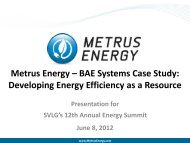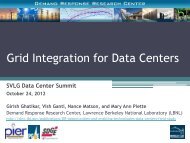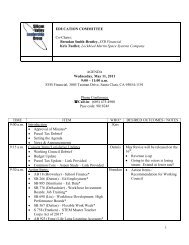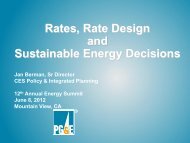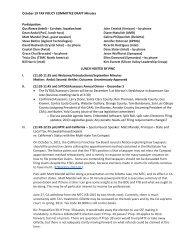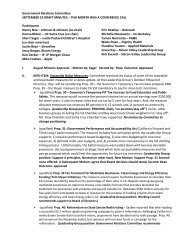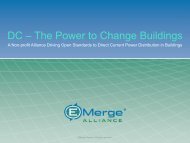2007 Silicon Valley Projections - Silicon Valley Leadership Group
2007 Silicon Valley Projections - Silicon Valley Leadership Group
2007 Silicon Valley Projections - Silicon Valley Leadership Group
You also want an ePaper? Increase the reach of your titles
YUMPU automatically turns print PDFs into web optimized ePapers that Google loves.
Tax Policy<br />
Compare this with San Diego’s high-tech area where the propit’s<br />
worth noting that while overall property tax rates in<br />
erty tax rate is only 1.11%—closer to the state average. Also,<br />
California seem modest, California has much higher property<br />
values than most other competitive areas. In fact, a 2003<br />
report from the US Census Bureau showed California as the<br />
state with the second highest property values in the nation,<br />
behind only Hawaii, a place where land is genuinely scarce.<br />
Tax Rates<br />
Sales Income Property<br />
California . . . . . . . . . . .6.25% . . . . . . . .8.84% . . . . . . . . .1.12%<br />
Tax Cost . . . . . . . . .$6,250,000 . . . .$8,840,000 . . . . .$1,120,000<br />
First Year Total . . . . . . . . . . . . . . . . . . . . . . . . . . . . . . .$16,210,000<br />
Massachusetts . . . . . . . .5.00% . . . . . . . .9.50% . . . . . . . . .1.33%<br />
Tax Cost . . . . . . . . .$5,000,000 . . . .$9,500,000 . . . . .$1,330,000<br />
First Year Total . . . . . . . . . . . . . . . . . . . . . . . . . . . . . . .$15,830,000<br />
Illinois . . . . . . . . . . . . . .6.25% . . . . . . . .7.30% . . . . . . . . .1.51%<br />
Tax Cost . . . . . . . . .$6,250,000 . . . .$7,300,000 . . . . .$1,510,000<br />
First Year Total . . . . . . . . . . . . . . . . . . . . . . . . . . . . . . .$15,060,000<br />
New Jersey . . . . . . . . .6.00% . . . . . . . .9.00% . . . . . . . . .0.00%<br />
Tax Cost . . . . . . . . .$6,000,000 . . . .$9,000,000 . . . . . . . . . . . . .-<br />
First Year Total . . . . . . . . . . . . . . . . . . . . . . . . . . . . . . .$15,000,000<br />
Virginia . . . . . . . . . . . .7.00% . . . . . . . .6.00% . . . . . . . . .1.11%<br />
Tax Cost . . . . . . . . .$7,000,000 . . . .$6,000,000 . . . . .$1,110,000<br />
First Year Total . . . . . . . . . . . . . . . . . . . . . . . . . . . . . . .$14,110,000<br />
Texas . . . . . . . . . . . . . .6.25% . . . . . . . .4.50% . . . . . . . . .2.62%<br />
Tax Cost . . . . . . . . .$6,250,000 . . . .$4,500,000 . . . . .$2,620,000<br />
First Year Total . . . . . . . . . . . . . . . . . . . . . . . . . . . . . . .$13,370,000<br />
New York . . . . . . . . . . .4.25% . . . . . . . .7.50% . . . . . . . . .1.53%<br />
Tax Cost . . . . . . . . .$4,250,000 . . . .$7,500,000 . . . . .$1,530,000<br />
First Year Total . . . . . . . . . . . . . . . . . . . . . . . . . . . . . . .$13,280,000<br />
North Carolina . . . . . . .4.50% . . . . . . . .6.90% . . . . . . . . .1.10%<br />
Tax Cost . . . . . . . . .$4,500,000 . . . .$6,900,000 . . . . .$1,100,000<br />
First Year Total . . . . . . . . . . . . . . . . . . . . . . . . . . . . . . .$12,500,000<br />
Colorado . . . . . . . . . . .2.90% . . . . . . . .4.63% . . . . . . . . .0.82%<br />
Tax Cost . . . . . . . . .$2,900,000 . . . .$4,630,000 . . . . . . .$820,000<br />
First Year Total . . . . . . . . . . . . . . . . . . . . . . . . . . . . . . . . .8,350,000<br />
Oregon . . . . . . . . . . . . .0.00% . . . . . . . .6.60% . . . . . . . . .1.48%<br />
Tax Cost . . . . . . . . . . . . . . . . .- . . . .$6,600,000 . . . . .$1,480,000<br />
First Year Total . . . . . . . . . . . . . . . . . . . . . . . . . . . . . . . .$8,080,000<br />
Washington . . . . . . . . .6.50% . . . . . . . .0.00% . . . . . . . . .1.29%<br />
Tax Cost . . . . . . . . .$6,500,000 . . . . . . . . . . . . .- . . . . .$1,290,000<br />
First Year Total . . . . . . . . . . . . . . . . . . . . . . . . . . . . . . . .$7,790,000<br />
ASSUMPTION: A company investing $100M in equipment used in<br />
manufacturing or R&D, with $100M of net income and $100M of<br />
property in the state it operates in.<br />
Best Practices - Lessons Learned<br />
News story after story show compelling examples of<br />
why companies choose to grow jobs and expand<br />
operations in states other than California. What do<br />
they have that we haven’t? In Arizona, companies are<br />
being drawn to the state by tax breaks creating 1,000<br />
direct jobs and thousands of indirect supporting<br />
industry<br />
Hold<br />
jobs.<br />
for Draft<br />
Arizona's<br />
<strong>Projections</strong><br />
recent adoption<br />
<strong>2007</strong><br />
of an 80<br />
percent sales factor formula, which stops short of<br />
considering only a company's sales tax calculations, has<br />
created a more positive environment for investment in<br />
the state. Most states give equal weight to three<br />
factors — the share of a company's total nationwide<br />
investments: payroll, property, and sales that occur in<br />
that particular state—<br />
when deciding tax burden. But<br />
under the sales factor formula, they would consider a<br />
higher fraction of the company's sales within the state.<br />
In the Arizona example, “about 70% of a chip plant’s<br />
cost is the equipment that goes into it, not the labor . .<br />
.a tax break can help mitigate that cost . . .[in this case]<br />
a huge boost from a new Arizona law that allows<br />
companies to cut income taxes if they spend at least $1<br />
billion in capital investments” (USA Today, 2005).<br />
Regarding sales and use taxes, it must be noted that CA’s lack<br />
of an exemption for productive business assets, which is prevalent<br />
in virtually every other state, makes California’s sales tax<br />
burden comparatively higher.<br />
A state or region’s tax rates may seem byzantine, but tax rates<br />
can provide companies’ insight into the costs of doing business<br />
in, and the potential competitive advantages of relocating<br />
to, certain regions. Especially when considering “greenfield”<br />
or new developments, the tax rates and especially the tax<br />
incentives that local economies provide can make or break site<br />
location decisions.<br />
To remain competitive, California, and municipalities in<br />
<strong>Silicon</strong> <strong>Valley</strong>, must embrace pro-growth tax policies and<br />
attempt to avoid the unintended consequences of the past.<br />
This chart illustrates where California stacks up relative to our<br />
competition throughout the country in terms of tax policies to<br />
promote new business and spur expansion.<br />
From an international perspective, corporate rates vary greatly,<br />
but the U.S. ties France for the fourth highest corporate tax<br />
rate out of the nations compared below. Although the countries<br />
of France, Germany, India are equal to or higher than the<br />
U.S., these countries have been successful in wooing U.S.<br />
manufacturing operations due to offsetting tax incentives and<br />
business friendly environments in those countries.<br />
49


